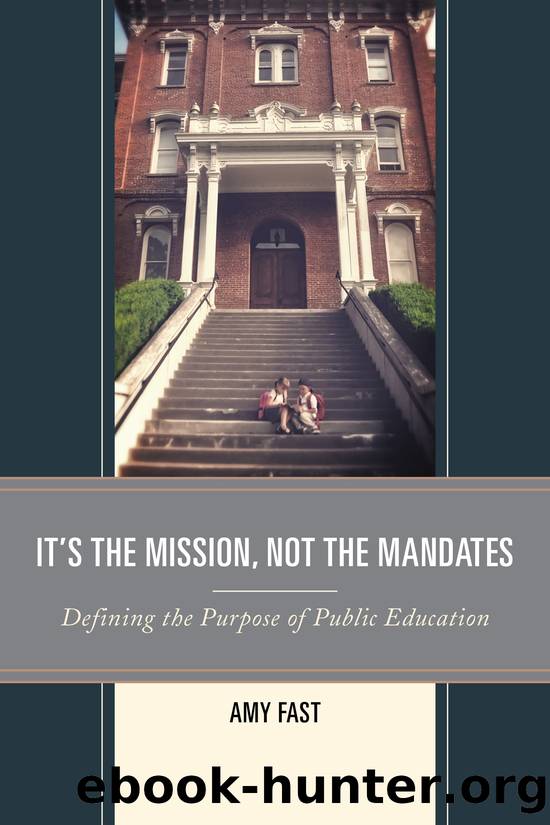It's the Mission, Not the Mandates by Fast Amy;

Author:Fast, Amy;
Language: eng
Format: epub
Publisher: Rowman & Littlefield Publishers
What the Public Wants
When we think of the public that public education is tasked to serve, we often think of community members, parents, and students. Yet, it was not community members, parents, or students who decided on the public school mission of helping U.S. businesses compete in the global economy. Ironically, it was not even community members, parents, or students who led the charge of closing the achievement gap between low-income and minority students and their peers.
Rather, these decisions are made by complex political processes, which are designed to represent the public interests. It is, however, worthwhile to invest in the unique needs and hopes of individual stakeholders and various stakeholder groups because they are the ones who operate in the trenches of the public school system, and without their buy-in the promise of our public schools stops at the steps of the capital building.
Familiesâ Desires
Let us begin by looking at the desires of our public school students. Largely, what students want most from their education is engagement. Essentially, they donât want to be bored. In fact, engagement in school is the number one reason that students choose to stay in school. This is especially true for students living in poverty (Gallup 2015; Jensen 2013). Unfortunately, many of our students are disengaged from school.
In one large-scale survey by Yazzie-Mintz (2007), only two percent of high school students said they were never bored. Over thirty percent of the students said that they did not have day-to-day interactions with their teachers (that would foster personal relationships and increase engagement), and seventy-five percent said that school was not interesting or relevant to their lives. According to Shernoff, Csiksquentmihalyi, Scheider, and Shernoff (2003), the average high school student spends twenty-five percent of her day in a state of complete apathy.
Yet another study found that students as young as fifth grade spent over ninety-percent of their time listening to teachers lecture or working silently and independently at their desks despite their preference for hands on and collaborative learning activities. And, sadly, our students from poverty are the least likely to receive engaging instruction and curriculum (Pianta et al. 2007).
Engagement refers to studentsâ enthusiasm for schoolâit is the intrinsic investment and effort in learning; and student engagement is the number one difference between low-performing schools and high-performing schools (Gallup 2015). However, there are many factors that contribute to engagement beyond simply a studentâs interest in the subject matter.
A studentâs sense of belongingness, her feeling of competence, the amount of autonomy she has, and the meaningfulness of her learning all factor into her level of engagement. Competence, autonomy, and meaningfulness as drivers of intrinsic motivation are themes that have been discussed by Pink (2011) when he points to the will-drivers of mastery (competence), purpose (meaningfulness), and autonomy, as well. Students, it seems, are no different from employees when it comes to what inspires them to harness their passion and pursue their purpose.
Students feel a sense of belonging if the culture of the school is one that seems to care about their positive well-being.
Download
This site does not store any files on its server. We only index and link to content provided by other sites. Please contact the content providers to delete copyright contents if any and email us, we'll remove relevant links or contents immediately.
Deep learning with TensorFlow and Keras by Derrick mwiti(865)
Understanding PDA Autism in Kids: A Guide for Parents and Teachers to Support Neurodiverse Learners by Jehu Len(713)
The Victorian Era: A Captivating Guide to the Life of Queen Victoria and an Era in the History of the United Kingdom Known for Its Hierarchy-Based Social Order by Captivating History(496)
Intersectionality in Educational Research by Dannielle Joy Davis; James L. Olive; Rachelle J. Brunn-Bevel; Susan R. Jones(476)
100 Ideas for Secondary Teachers: Engaging Parents by Janet Goodall & Kathryn Weston(475)
Writing Solid Code: Development Philosophies for Writing Bug-Free Programs by Steve Maguire(457)
How to be assertive in any situation by Hadfield Sue & Hasson Gill(456)
Brain Teasers to Build Critical Thinking Skills: Brain Exercises for Tech, Banking, Case Interview Prep, and to Keep Your Mind Sharp by Kris Safarova(449)
Brain Teasers to Build Critical Thinking Skills by Safarova Kris(448)
Python 101 - Fundamentals by Sam(411)
Critical Curriculum Leadership : A Framework for Progressive Education by Rose M. Ylimaki(407)
The Art of Emotional Validation: Improve Your Communication Skills and Transform Your Relationships by Validating Emotions and Feelings by Emily Wright(376)
The Knights Templar: An Enthralling History of the Rise and Fall of the Most Influential Catholic Military Order by Wellman Billy(367)
The Future Knowledge Compendium by Ellyard Peter;(364)
A Beginner's Guide to SSD Firmware by Unknown(362)
What Every Teacher Should Know about Learning, Memory, and the Brain by Tileston Donna E. Walker;(360)
NumPy : From Basic to Advance by bisht Karan Singh(348)
Making Connections in and Through Arts-Based Educational Research by Hala Mreiwed Mindy R. Carter Sara Hashem Candace H. Blake-Amarante(342)
Foundations of Educational Research by Victoria Elliott(335)
